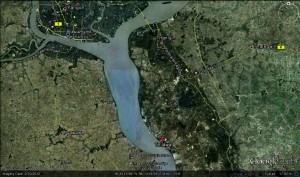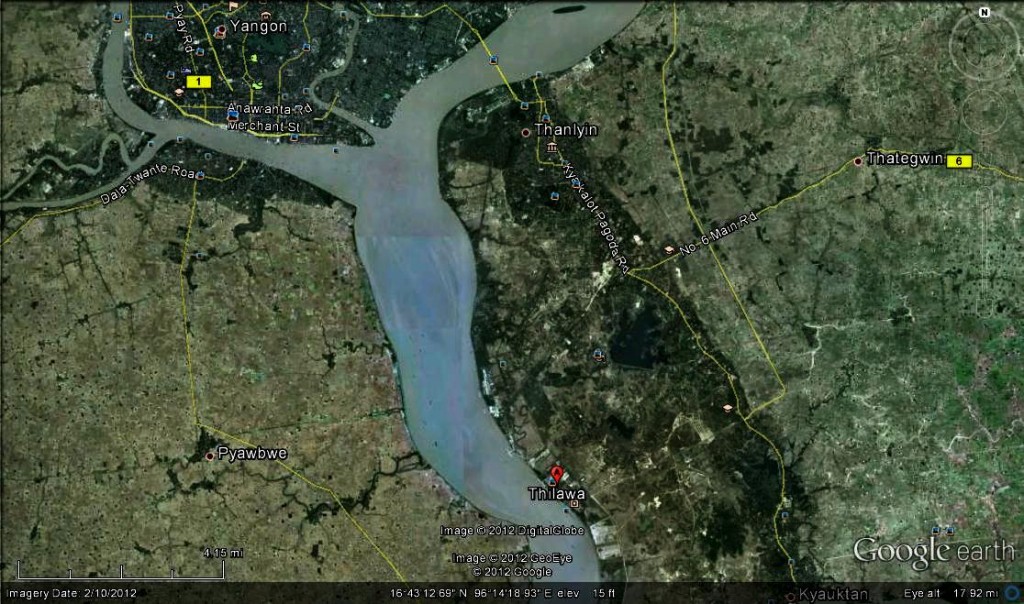 YANGON–Planning for one of the largest industrial parks in Asia is under way in Myanmar, President Thein Sein said "Other countries have talked to us, but we're going to give the entire project to Japan,". "First, we'd like you to develop just 400 hectares by 2015."
YANGON–Planning for one of the largest industrial parks in Asia is under way in Myanmar, President Thein Sein said "Other countries have talked to us, but we're going to give the entire project to Japan,". "First, we'd like you to develop just 400 hectares by 2015."
The Thilawa Special Economic Zone (SEZ) project is about an hour's drive from downtown Yangon, Myanmar's largest city. Fields of grass and rice paddies stretch as far as the eye can see; at 2,400 hectares, the zone will house an industrial park.
It began with a personal connection. Hideo Watanabe, chairman of the Japan Myanmar Association and former postal and telecommunications minister, had a 20-year acquaintance with Thein Sein, the Myanmar president. When Watanabe visited Myanmar last year, the president pressed him for Japan's help in a development project.
Thilawa Special Economic Zone, Yangon, Myanmar, Google Maps
The Japanese government spotted valuable opportunities. If a special economic zone was set up with proper power, water and sewage systems, it would attract foreign investment, create jobs and foster support for democratic reforms in Myanmar.
Japan's domestic market has been shrinking as the birthrate declines and the population ages. The government saw Myanmar's population of 62 million a chance to create production centers with a cheap work force, which would then channel Southeast Asia's growth potential to Japan. Tsutomu Murasaki, an official in charge of strategic export negotiations at Japan's trade ministry, mentioned another goal: "To strengthen the competitiveness of Japanese companies."
In April, Japan's government decided to write off debts of roughly 300 billion yen ($3.84 billion) from past loans and embark on new lending to support Myanmar's development. The two countries agreed to form joint ventures, while Japanese firms would handle construction of the industrial park.
But then Myanmar threw a whole new element into the mix. Japan had estimated construction would take 20 years, a figure based on prior experience with industrial parks; the Burmese government thought differently.
"We want you to clear the land and build factories by 2015," said a prominent Cabinet member. 2015 is when the ruling party is expected to square off against the opposition, led by Aung San Suu Kyi, famous for taking steps to end its military dictatorship, institute democratic reforms and open its economy.
Then a threat arose to split the project. "If Japan can't do it alone, we'll divide the work four ways and get China and South Korea involved," suggested one Myanmar official.
Myanmar is justifiably called Asia's last frontier, with its geopolitically significant location between China and India. Worldwide, nations are scrambling to invest there.
Aspiring investors include China, which first approached Myanmar's government with a plan to develop Thilawa; South Korea has also courted attention, treating Myanmar to a visit by its president, the first in 29 years. OilSeedCrops Editor: Infrastructure projects will go to the highest bidder period. “Everyone is in the pool” as my Taiwanese friend told me. Myanmar will negotiate any and all terms for its development. Get used to it.
Irritation mounted on the Japanese side. "We will not issue any yen loans unless we can lead development," said a senior official at the trade ministry.
Thilawa Deep-Sea Port south of Yangon, Myanmar. Google Maps
BALANCE SHIFTS
Japan has also been thrown by shifts in the regional balance. Southeast Asian diplomacy used to be one of Japan's strengths, and the government would disburse generous amounts of foreign aid to create closer political partnerships.
But things began to change in the late 1990s. As Japan struggled with deflation, China grew rapidly and its trade expanded throughout the region. Beijing strengthened its regional presence with foreign relations based on an approach termed smile diplomacy. Meanwhile, South Korea has been exerting influence by riding the so-called "Korean wave" of popular culture.
And then, with a flourish, Myanmar opened its economy.
"If we can't play an important role when Myanmar is getting its economy off the ground, we'll be thrust to the sidelines of Southeast Asian diplomacy," said a senior official at the Foreign Ministry. Japan's government considered the Thilawa development project the pillar of its assistance to Myanmar, and the cornerstone to its foreign relations.
On July 25 in the Myanmar capital of Naypyidaw, Watanabe and trade ministry official Murasaki were among a Japanese delegation that met with Tin Naing Thein, national planning and economic development minister and a key figure behind the Thilawa development project.
According to multiple people present, there then followed three and a half hours of highly heated discussion, which at times left the Japanese side's interpreter lost for words.
The minister tried to force our Japanese counterparts into accepting Myanmar's new deadline. "The president wants to complete the project by 2015," he said. Watanabe shot back: "You're the one who's impeding the project."
The confrontational atmosphere eased the following day. The Japanese delegates met with President Thein Sein at 10 a.m. This time, the meeting included Yoshito Sengoku, acting chair of the Democratic Party of Japan's Policy Research Committee.
"Other countries have talked to us, but we're going to give the entire project to Japan," the president said. "First, we'd like you to develop just 400 hectares by 2015."
The Japanese delegates were relieved. It was a fully satisfactory about-face from the previous day's confrontation with Tin Naing Thein.
One high-level Myanmar government official explained the trial like this: "If we had just given everything to Japan from the outset, the legislature and the international community would have asked, 'Why only Japan?'"
On July 27, the Japanese government formed a Thilawa development team comprising representatives of relevant ministries and agencies.
Among those joining private companies as members of the project would be the Japan International Cooperation Agency (JICA) and the Japan Bank for International Cooperation (JBIC). Thus the public and private sectors have finally embarked on the project's initial phase.
However, wrinkles could reappear.
"If development fails to go smoothly, the idea of splitting the project up might resurface," warned one Japanese government source.
A senior executive at a major Japanese trading firm summed it up: "For now, Myanmar is in a position to pick and choose."
FROM WEST TO EAST
As Japan, the United States and Europe suffer from economic stagnation, money and people continue to flee the quicksands of places like Greece, the epicenter of the euro crisis. Meanwhile, capital is flooding into Myanmar, the most promising new star on the world stage. The center of the global economy is increasingly shifting from west to east.
The Mingaladon Industrial Park sits on the northern outskirts of Yangon. Until three years ago, the place was moribund, but by early 2012, all 41 plots of land had been sold to Taiwanese and South Korean firms. At the time, Japanese companies had held back from investing because Western sanctions were still in place.
Although latecomers, Japanese firms are now preparing to invest in Myanmar.
Some troublesome issues persist, including the country's shoddy infrastructure–such as poor roads and electricity supply–and the results of the upcoming general election could disrupt the country's political stability.
Even so, many observers are optimistic.
"Reforms are proceeding faster than anyone could have predicted," said Serge Pun, a leading property tycoon of ethnic Chinese descent, who expanded his Asian real-estate empire to Myanmar. "This resembles China when it was embarking on economic reform in the 1990s."
Original Link The Asahi Shimbun, Asian and Japan Watch
